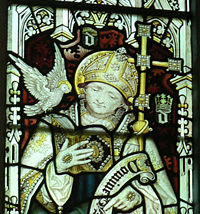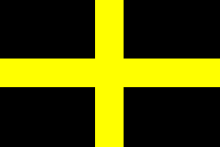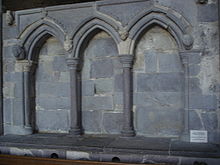- Saint David
-
For other uses, see Saint David (disambiguation).
Saint David 
19th century stained glass window
in Jesus College Chapel, Oxford.Bishop Born date unknown, c.500
Caerfai, Pembrokeshire, WalesDied 1 March, c.589
St David's, Pembrokeshire, WalesHonored in Catholic Church,
Anglican Communion,
Orthodox ChurchMajor shrine St David's Cathedral, Pembrokeshire, Wales
shrine largely extant,
controversial bones in casketFeast 1 March Attributes bishop with a dove,
usually on his shoulder, sometimes standing
on a raised hillockPatronage Wales; Pembrokeshire; vegetarians; poets Controversy The earliest of the supposed bones of Saint David and Saint Justinian housed in a casket in the Holy Trinity Chapel of St David's Cathedral have been carbon-dated to the 12th century. Saint David (c. 500–589) (Welsh: Dewi Sant) was a Welsh Bishop during the 6th century; he was later regarded as a saint and as the patron saint of Wales. David was a native of Wales, and a relatively large amount of information is known about his life. However, his birth date is still uncertain, as suggestions range from 462 to 512. The Annales Cambriae has his death at 601, which would move his birth date forward.[1]
Contents
Early life
David became a pupil of Saint Illtud at Llanilltud Fawr (English: Llantwit Major) like Saints Samson of Dol, Gildas and Paul Aurelian.[2] Rhygyfarch, the late 11th century author of the saint's life story (see below), wrote that David was the son of sanctus rex ceredigionis, where Sanctus has been interpreted as a proper name and its owner honoured by Welsh Christians as Sandde, King of Ceredigion. However, this Latin phrase can equally well mean simply "holy king of Ceredigion". The king of Ceredigion around the time of David's birth would have been Usai. According to Rhygyfarch, Sandde was his brother, so probably only a king of part of Ceredigion. They were sons of King Ceredig, founder of Ceredigion. The saint was conceived through violence and his mother, St. Non, the daughter of Lord Cynyr of Caer Goch (in Pembrokeshire), gave birth to him on a cliff top during a violent storm. The site is marked by the Chapel of St Non. David was educated at what is usually taken to be Whitland in Carmarthenshire under Saint Paulinus of Wales and was baptised by St. Ailbe, Bishop of Emly.[3]
Monasticism
Many of the traditional tales about David are found in the Buchedd Dewi, a hagiography written by Rhygyfarch in the late 11th century. Rhygyfarch claimed it was based on documents found in the cathedral archives. Modern historians are sceptical of some of its claims: one of Rhygyfarch's aims was to establish some independence for the Welsh church, which had refused the Roman rite until the 8th century and now, following the Norman invasion of England in 1066, was to seek a metropolitan status equal to that of Canterbury.
He became renowned as a teacher and preacher, founding monastic settlements and churches in Wales, Dumnonia and Brittany in a period when neighbouring tribal regions (that were to be overrun by Anglo-Saxon or Frankish tribes over the following three hundred years) were still mostly pagan.[citation needed] He rose to a bishopric and presided over two synods as well as going on pilgrimages to Jerusalem (where he was anointed as an archbishop by the Patriarch) and Rome. St David's Cathedral stands on the site of the monastery he founded in the 'Glyn Rhosyn' valley in Pembrokeshire.
The Monastic Rule of David prescribed that monks had to pull the plough themselves without draught animals, must drink only water eat only bread with salt and herbs and spend the evenings in prayer, reading and writing. No personal possessions were allowed: to say "my book" was an offence. He lived a simple life and practiced asceticism, teaching his followers to refrain from eating meat or drinking beer. His symbol, also the symbol of Wales, is the leek (this is questioned by some authorities and largely comes from reference in Shakespeare's Henry V, VI 1). His emblem is a dove.
His best-known miracle is said to have taken place when he was preaching in the middle of a large crowd at the Synod of Brefi: the village of Llanddewi Brefi is said to stand on the spot where the miracle occurred. When those at the back complained that they could not see or hear him the ground on which he stood is reputed to have risen up to form a small hill so that everyone had a good view. A white dove was seen settling on his shoulder — a sign of God's grace and blessing. John Davies notes that one can scarcely "conceive of any miracle more superfluous" in that part of Wales than the creation of a new hill.[4] A more mundane interpretation is that he simply recommended that the synod participants move to the hilltop. In works of art, David is frequently shown with a dove on his shoulder. It is significant that David is said to have denounced Pelagianism during this incident and that he was anointed archbishop by the Patriarch of Jerusalem, a position confirmed at the Synod of Llanddewi Brefi by popular acclaim according to Rhygyfarch.[5] The claim of St David's Metropolitan Status as an archbishopric (and thus of the same status as Canterbury) was later supported by Bernard, Bishop of St David's, Geoffrey of Monmouth and Gerald of Wales.
Connections to Glastonbury
Rhygyfarch stated that Glastonbury Abbey was amongst the many churches David founded.[6] Around forty years later William of Malmesbury believing the Abbey was older than this, said that David visited Glastonbury intending only to rededicate the Abbey, as well as to donate a travelling altar including a great sapphire. He had a vision of Jesus, who said that "the church had been dedicated long ago by Himself in honour of His Mother, and it was not seemly that it should be re-dedicated by human hands". So David instead commissioned an extension to be built to the abbey, east of the Old Church. (The dimensions of this extension given by William were verified archaeologically in 1921). One manuscript indicates that a sapphire altar was among the items King Henry VIII confiscated from the abbey at its dissolution a thousand years later. There are unverifiable indications that the sapphire may now be among the Crown Jewels.
Death
 The Flag of Saint David.
The Flag of Saint David.
It is claimed that David lived for over 100 years, and he died on a Tuesday 1 March (now St David's Day). It is generally accepted that this was around 590, making the actual year 589. The monastery is said to have been 'filled with angels as Christ received his soul.' His last words to his followers were in a sermon on the previous Sunday. Rhygyfarch transcribes these as 'Be joyful, and keep your faith and your creed. Do the little things that you have seen me do and heard about. I will walk the path that our fathers have trod before us.' 'Do the little things in life' ('Gwnewch y pethau bychain mewn bywyd') is today a very well known phrase in Welsh.
David was buried at St David's Cathedral at St David's, Pembrokeshire, where his shrine was a popular place of pilgrimage throughout the Middle Ages. During the 10th and 11th centuries the Cathedral was regularly raided by Vikings who removed the shrine from the church and stripped off the precious metal adornments. In 1275 a new shrine was constructed, the ruined base of which remains to this day (see photo), which was originally surmounted by an ornamental wooden canopy with murals of St David, St Patrick and St Denis of France. The relics of St David and St Justinian were kept in a portable casket on the stone base of the shrine. It was at this shrine that Edward I came to pray in 1284. During the reformation Bishop Barlow (1536–48), a staunch Protestant, stripped the shrine of its jewels and confiscated the relics of David and Justinian.
Reputation
David's popularity in Wales is shown by the Armes Prydein Vawr c.930, a popular prophetic poem in which the poet prophesied that in the future, when all might seem lost, the Cymry (the Welsh people) would unite behind the standard of David to defeat the English; A lluman glân Dewi a ddyrchafant ("And they will raise the pure banner of Dewi").
Unlike many contemporary 'saints' of Wales, David was officially recognised by the Vatican by Pope Callixtus II in 1120, thanks to the work of Bernard, Bishop of St David's. Music for his office has been edited by O.T. Edwards in Matins, Lauds and Vespers for St David’s Day: the Medieval Office of the Welsh Patron Saint in National Library of Wales MS 20541 E (Cambridge, 1990)
David's life and teachings have inspired a choral work by Welsh composer Karl Jenkins, Dewi Sant. It is a seven-movement work that is best known for the classical crossover series Adiemus, which intersperses movements reflecting the themes of David's last sermon with those drawing from three Psalms. An oratorio by another Welsh composer Arwel Hughes, also entitled Dewi Sant, was composed in 1950.
Saint David is also thought to be associated with corpse candles, lights that would warn of the imminent death of a member of the community. The story goes that David prayed for his people to have some warning of their death, so that they could prepare themselves. In a vision, David's wish was granted and told that from then on, people who lived in the land of Dewi Sant (Saint David) "would be forewarned by the dim light of mysterious tapers when and where the death might be expected." The color and/or size of the tapers indicated whether the person to die would be a woman, man, or child.[7]
See also
- Christian vegetarianism
- St David's Cathedral
- St David's Day
- Corpse Candles
Notes
- ^ Toke, Leslie (1908). "St. David". The Catholic Encyclopedia. New York City: Robert Appleton Company (print); New Advent (web). http://www.newadvent.org/cathen/04640b.htm. Retrieved 25 May 2009.
- ^ The life of St Illtud composed in Cemis, Pembrokeshire, in the 12th C. Found in the British Museum Cotton MS Vespasian A xiv
- ^ Toke, Leslie (1908). "St. David". The Catholic Encyclopedia. New York City: Robert Appleton Company (print); New Advent (web). http://www.newadvent.org/cathen/04640b.htm. Retrieved 25 May 2009.
- ^ Davies, John (1993/2007). A History of Wales. London: Penguin. pp. 74.
- ^ Rhygyvarch's Life of St David. A.W. Wade-Evans's (Ed.) sections, 48, 53. ISBN 978-1-889298-03-0
- ^ Rhygyvarch's Life of St David. A.W. Wade-Evans's (Ed.) section 13. ISBN 978-1-889298-03-0
- ^ Marie Trevelyan. Folk-Lore and Folk-Stories of Wales. London, 1909. p. 178. http://books.google.com/books?id=zmYHrsC6cYIC&printsec=frontcover. Retrieved 2010-09-18.
References
- Vitae Sanctorum Britanniae et Genealogiae (Latin), ed. Arthur W. Wade-Evans. Cardiff: University of Wales Press, 1944.
- St. David the Briton, in St. Joseph of Arimathea at Glastonbury Or the Apostolic Church of Britain by Lionel Smithett Lewis, page 198
- St. David's Day section of Observations on the popular antiquities of Great Britain: chiefly chiefly illustrating the origin of our vulgar customs, ceremonies and superstitions, Volume 1 (Google Books facsimile) by John Brand, page 102
- St. David's Day section of Observations on popular antiquities, chiefly illustrating the origin of our vulgar customs, ceremonies and superstitions : Arranged and rev., with additions, Volume 1 (ASCII text) by John Brand
External links
Categories:- 589 deaths
- 6th-century bishops
- 6th-century Christian saints
- Anglican saints
- Ascetics
- Bishops of St David's
- Celtic people
- Eastern Orthodox saints
- History of Pembrokeshire
- People from Pembrokeshire
- Welsh royalty
- Welsh saints
- Welsh Roman Catholic saints
- Welsh vegetarians
- Year of birth uncertain
Wikimedia Foundation. 2010.



